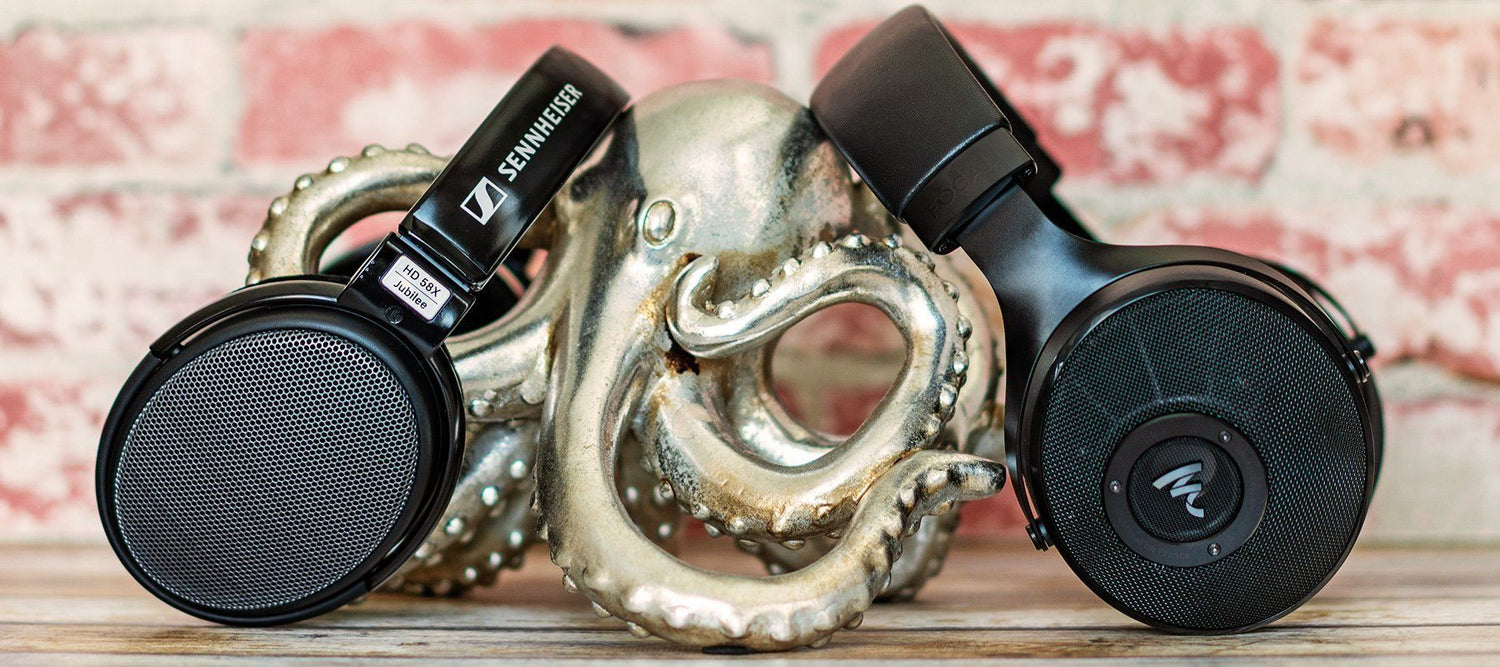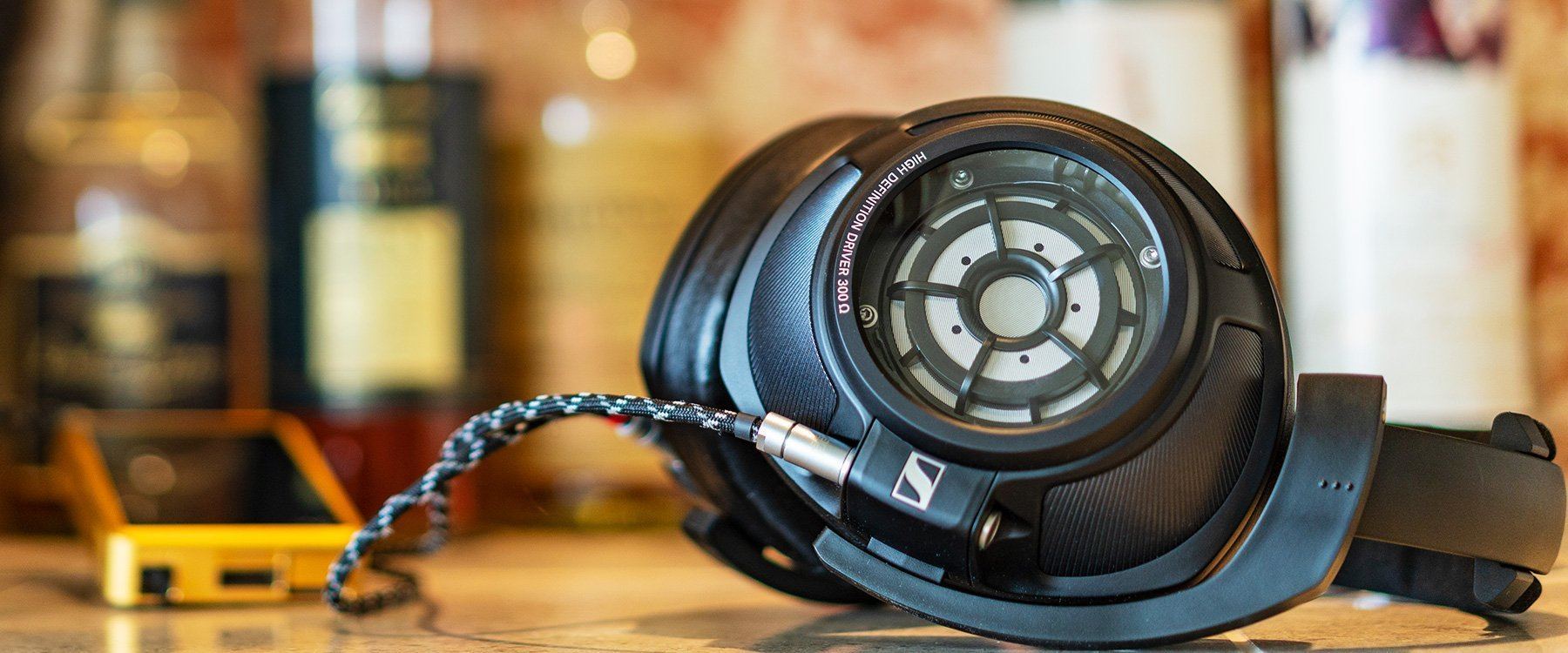By Percy Wegmann (@pwjazz)
Summary
The Massdrop x Focal Elex and Massdrop x Sennheiser HD58X sound more similar than different, but for my own use, I prefer the HD58X, price no object. The slightly warm but mostly neutral sound signature works well on pretty much all of the music to which I listen and I can enjoy it at low volumes. It’s also far more comfortable for me to wear than the Elex. It loses to the Elex on technicalities like speed and detail retrieval, and it’s less smooth, but it’s pretty darned good across the board, images exceptionally well, and renders macrodynamics better than the Elex (which surprised me). The HD58X has plenty of punch, well-enough extended bass and treble, and it generally sounds cohesive. It’s also smoother than what I remember of the HD 600 and therefore “smooth enough”. The gap in speed and detail retrieval can partially be closed with solderdude’s felt mod, which I’ve been emulating with EQ and will probably apply for real.
 If there’s one song that best demonstrates why I love the HD58X, it’s Stevie Ray Vaughan’s Tin Pan Alley from “Couldn’t Stand the Weather”. With texture, punch, dynamics, reverb and other goodies, it’s a sonic treasure box and real desert island stuff! By contrast, listening with the Elex I found a lot of songs that sounded impressive from a critical listening perspective, but nothing that tickled my musical fibers like the HD58X does.
If there’s one song that best demonstrates why I love the HD58X, it’s Stevie Ray Vaughan’s Tin Pan Alley from “Couldn’t Stand the Weather”. With texture, punch, dynamics, reverb and other goodies, it’s a sonic treasure box and real desert island stuff! By contrast, listening with the Elex I found a lot of songs that sounded impressive from a critical listening perspective, but nothing that tickled my musical fibers like the HD58X does.
The Details
Having recently gone on a DSP binge and sold my Beyerdynamic DT 1990 because I was having so much fun with my Audeze LCD2C, I came off that binge wanting to own some headphones that don’t need any EQ or crossfeed to sound good. I used to own an HD600 which fit the bill but failed to impress with its bass performance, and it had a roughness to its sound that I couldn’t ignore. Hoping that it might sound like a “fixed” HD600, I picked up a Sennheiser HD58X on eBay. Soon after, an open box Elex became available for a good price on Blinq. I’d always wanted to hear the famed Focal sound and I hoped that it would sound like my old DT 1990 without the big treble spike, so I picked up a pair. I’ve owned neither very long, but I’ve listened to both long enough to form some impressions. I find myself constantly reaching for the HD58X over the Elex and so the Elex will move on to a home where it might find more love.
Background and Disclaimers About Me
I’ve lost enough high frequency hearing that I don’t hear over about 14 or 15 kHz. Since I’d like to preserve my hearing, I tend to listen at low levels (70 dBA or below). I listen to pretty much all kinds of music, but skew towards stuff that includes at least some acoustic instruments and unprocessed human voices. I listen to a lot of music during the day while I work as a programmer, I occasionally do some focused critical listening for enjoyment and writing reviews like this one, and I like to listen in the evenings for relaxation. I used to enjoy ballroom dancing with my wife prior to the arrival of our kids and so enjoy a good beat about as much as anyone. I casually play the piano and am learning to play the ukulele together with my young son. Some people might mistake me for musically inclined until they hear me sing, at which point they’ll realize that I have awful pitch.
Test Playlist
- Tin Pan Alley on “Couldn’t Stand the Weather” by Stevie Ray Vaughan
- Get Lucky on “Random Access Memories” by Daft Punk
- Angel on “Mezzanine” by Massive Attack
- Jambone and Tio Macaco on “We Like It Here” by Snarky Puppy
- Abraham’s New Gift on “Alive” by Phronesis
- Second Hand News on “Rumours” by Fleetwood Mac
- Africa on “Toto IV” by Toto
- Windowpane on “Damnation” by Opeth
- 11:11 on “11:11” by Rodrigo y Gabriela
- Metropolis Pt. 1 on “Images and Words” by Dream Theater
- I’m Nowhere and You’re Everything on “Deceiver” by Chris Thiele
- La Moldau conducted by Ferenc Fricsay on Deutsche Grammophon by Bedrich Smetana
- Le Nozze De Figaro starring Karl Böhm on Deutsche Grammophon by Wolfgang Amadeus Mozart
- St. Matthew’s Passion conducted by Ian Bostridge by J.S. Bach
- Singet Dem Herrn ein neues Lied on “Bach: Motets” performed by R.I.A.S. Chamber Choir
- Rachmaninoff Vespers performed by Rober Shaw Festival
All songs were in Red Book FLAC (16/44.1) from CD rips or web download from Bandcamp, played back with either Roon or USB Audio Player Pro on Android.
Commonalities
Amp Pairing
I listened to both headphones out of an LG V20, a Topping NX4 and a Hifiberry feeding a Schiit Magni 3 as well as a Garage1217 Ember II tube amp with an RCA 12AU7 clear top tube. The tube amp didn’t do either headphone any favors, taking away too much body from the Elex and too much detail from the HD58X. All three solid state amps did well. The LG V20 sufficiently powers both (I used about 25-35% volume most of the time). Both sounded even better from the NX4, which filled in the Elex bottom end a bit more and seemed to bring out a some more detail and clarity from the HD58X. The Elex sounded best from the Magni 3 which filled in its bottom end even more.
Interestingly, the volume on both headphones measured and sounded about the same without having to adjust the settings on the LG V20, so that made it easy to switch back and forth for testing.
Imaging and Soundstage
Both of these headphones image very well within what one might call “intimate” soundstages which to me sound more natural than wider soundstages like on the HE400i or HD598. In particular, I never feel the need to turn on crossfeed to narrow the stereo image. Both headphones separate instruments very well, and they both allow me to precisely place sounds within a contiguous soundstage, unlike the LCD2C which separates well but places everything into just one of three blobs (left, center, right). The Elex also achieves something special in that it places the image more in front of me than I’m used to from headphones, making it very “speaker-like” in that regard.
11:11 and the 2nd track from The Marriage of Figaro really show off the imaging. On The Marriage of Figaro, both headphones convey the sense of actually sitting in an opera house. I can easily imagine the vocalists on stage in front of me, with the male just right of center, the female just left of center, and the orchestra filling in around them. 11:11 doesn’t contain many parts, just a couple of guitars, some banging on the guitars and some clapping, but the recording places each one in a slightly different location across the stereo image and both headphones use the available soundstage to the fullest.
Overall Tonality and Timbre
Both headphones are tuned neutrally and render voices and acoustic instruments realistically. Male and female vocals are well balanced with each other and with the rest of the instrumentation. Both headphones have what I would call “enough” treble, providing enough energy to cymbals and sweetness to female vocals, but never becoming sibilant or fatiguing. Both deviate a bit from neutral, with the HD58X a little towards the warm side and the Elex a little to the lean side. I’ve found that I definitely prefer the HD58X’s warmer tilt, which gives voices and instruments a body that they lack with the Elex (unless I turn up the volume).
My measurements (relative to a Harman-like target) illustrate the general similarity in their tonal balance versus something like the LCD2C.

Mid-Bass
In most modern music, bass guitar and drum provide the beat, and it’s important for these be clear, articulate, and punchy. I find that dynamic driver headphones often get the “punchy” part but sometimes struggle with “clear and articulate”. Both of these headphones really nail it all around. Tracks like Get Lucky and Metropolis Pt 1 show off what these headphones can do, with a fast driving beat in the former which makes me want to dance, and some fast double-bass drumming and highly technical bass guitar lines in the latter that make me want to bang my head while flashing the sign of satan.
Sub-Bass
Open-backed dynamic drivers often suffer from pretty severe sub-bass rolloff and dramatically increased distortion in this region. Both of these headphones roll off a little but extend surprisingly well and remain reasonably articulate down there. Listening to Angel, I can hear low notes with some definition, not just a generic rumble. Neither of these rivals my LCD2C for bass performance and if I were to sit down for a listening session dedicated to electronic music, I would stick with the LCD2C, but for the occasional deep bass track these both get the job done. The HD58X does suffer from more severe bass rolloff when wearing glasses, so for critical listening I must listen blind!
Percussion
Percussion covers a wide range of sounds, from kick drums to toms and snares, from triangles and shakers to cymbals and hi hats, from claps to beating on a guitar’s body. Percussion provides both a beat and interesting accents to the music. Counterintuitively, even lower toned percussion like toms seem to need some energy in the treble to sound punchy and believable, and thankfully both of these headphones deliver on that score. The two Snarky Puppy songs on the test playlist show off both headphones’ percussive capabilities very well, and also their imaging on large jazz ensembles. I enjoyed listening to all the percussive instruments surrounding my head!
Microdynamics
I’m still learning what “microdynamics” really means, but their rendering of the tremolo in the voices around 1:00 into Get Lucky seems like a good example of these headphones’ capabilities to portray small volume swings.
To Elex’s Advantage
Speed, Clarity and Detail Retrieval
Partially because of its leaner sound but also because of better speed, the Elex overall sounds clearer and more detailed. Whereas the HD58X always has a tiny bit of haziness to its background that reduces its resolution a bit, the Elex presents a perfectly dark background out of which its very detailed sounds seem to emerge. This is convincingly demonstrated on Abraham’s New Gift.
However, solderdude’s felt mod narrows this gap. I emulated it with some EQ, and bringing down the mid-bass hump in this way did improve perceived clarity and detail, and made the background a bit darker. It’s still no Elex, but it’s not bad. In particular, while doing this comparison I noticed that Africa has some brief quiet voices on the left channel at 0:03, which I’d never noticed before.
Build/Aesthetics
Unlike the plastic-fantastic HD58X, the largely metal Elex conveys a sense of being a premium product whilst sitting on the desk or held in hand.
To HD58X’s Advantage
Macrodynamics
Tin Pan Alley and La Moldau both use drastic volume swings to convey emotion. Tin Pan Alley’s sounds explode out of nowhere and fade as quickly as they appeared, jerking the listener around as Stevie Ray pulls her along through his solo. A drum hit and guitar strum that mimic a gunshot at 5:11 begin a stretch with particularly strong macrodynamics. In La Moldau the swings are more gradual, building energy in a way that evokes the might of a meandering stream turning into a raging river. The HD58X renders these dynamic swings better than the Elex, conveying more of the emotion in these songs.
Guitars
Elaborating on timbre, I find that acoustic and electric guitars sound more full bodied and overall better on the HD58X because of its warmer tonal tilt. The electric guitar at the end of Second Hand News demonstrates this well–on the HD58X it has body, crunch and bite, on the Elex it’s all bite.
Low Volume Listening
The Elex gains body by turning up the volume to 75 dBA or higher, to which the Elex responds beautifully in other ways too. Weight improves, clarity increases and everything just sounds more vivid and punchy. Turn up the HD58X too much, and it starts to sound muddy and congested. This is less of an issue after the felt mod and also less of an issue on the more powerful solid state amps, but still generally true.
However, I prefer listening at lower volumes to protect my hearing, and at my listening volumes the HD58X sounds better balanced to my ears. Someone who listens at higher volumes might better appreciate the Elex.
Comfort
The Elex may look great in my hand, but the HD58X feels great on my head. It’s significantly lighter, its headband design avoids hotspotting on the crown of my head, its oval ear pads provide enough room for my pointy ears, and after manually loosening the clamp it clamps strongly enough to feel secure on my head yet gently enough to avoid causing discomfort, even when I wear glasses. About the only place where the Elex wins on comfort is in its slightly deeper ear cups, which prevent my ears from touching the driver like they do on the HD58X, but it’s a small consolation when their small round openings fold either the top or the bottom of my ears inwards. Also, the Elex includes a heavy, kinky abomination of a cable that may look expensive but isn’t worth $5 as far as I’m concerned. Thankfully the cable is easily replaced.
Conclusion
Sound wise, both of these headphones are very, very good. For someone who tends to listen at slightly higher volumes than I, the Elex can certainly outperform the HD58X in most dimensions and reveals a clarity that remains out of the HD58X’s reach at any volume. However, at the low volumes I use, the HD58X sounds very cohesive and is good enough across the board that it makes it a pleasure to listen to just about anything. Beyond that, while the Elex can sound very technically impressive on the right tracks at the right volume, not once did it allow me to lose myself in the music the way that I can with the HD58X. Last but not least, I personally find the HD58X much more comfortable. Given that it includes an actually useful cable retails for almost 1/5th of the Elex, it’s a no-brainer pick for me.
Someone on Reddit recently suggested that a happy audiophile is one who has figured out the lower limit of what equipment will deliver near maximum enjoyment. I’ll need to spend more time with it before I come to a final conclusion, but the HD58X + LG V20 augmented by an NX4 for critical listening could be my sweet spot. Of course that would mean giving up the pursuit of new headphones, which is a whole 'nother subject!
P.S. It occurred to me after writing this comparison that the HD58X, like the rest of the Sennheiser 600 family, really excels at singer/songwriter folk music because of its spectacular rendering of vocals and guitars. Other than one Chris Thiele song, my test playlist didn’t really hit this category much. I’m happy to say that, as expected, the HD58X sounds fantastic on albums like Joni Mitchell’s “Blue”!

Measurement Notes
Measurements were made on a MiniDSP E.A.R.S. following the recommendations in the MiniDSP manual, but at a lower SPL to match my typical listening level. The test tones were played from an LG V20 phone using USB Audio Player Pro with no DSP active. The frequency response uses the MiniDSP-provided HEQ compensation which according to MiniDSP is similar to (but not identical to) the Harman target response.
Note - the LCD2C measurements were taken from an earlier measurement session and were measured at 84dB and then shifted for comparison to the Elex and HD58X.

-Percy Wegmann (@pwjazz)
---
Join the discussion about this Massdrop x Focal Elex vs. Massdrop x Sennheiser HD58X comparison at "The HEADPHONE Community".




Leave a comment
All comments are moderated before being published.
This site is protected by hCaptcha and the hCaptcha Privacy Policy and Terms of Service apply.